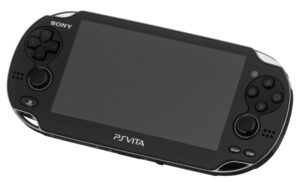
The PlayStation Vita (PS Vita), released in 2011, was a handheld console from Sony that aimed to combine traditional console-quality gaming with the modern, touch-based features of smartphones. While praised for its powerful hardware and innovative features, it ultimately struggled to compete with the highly successful Nintendo 3DS and the growing dominance of mobile gaming.
Key innovations and features
The PS Vita was packed with advanced technology for a portable device at the time:
- Dual analog sticks: Unlike its predecessor, the PSP, the Vita featured two full analog sticks, providing a level of control comparable to a home console.
- Touchscreen and rear touchpad: The console was defined by its dual touch inputs: a 5-inch multi-touch OLED screen on the front and a multi-touch pad on the back. This enabled new gameplay possibilities, with some games allowing you to interact with the game world from the rear.
- Powerful hardware: The Vita ran on a quad-core ARM Cortex-A9 processor and a quad-core PowerVR SGX543MP4+ GPU, giving it a performance level that was closer to the PlayStation 3 than the PlayStation Portable.
- Remote Play: The Vita featured Remote Play, which allowed users to stream and play most PlayStation 4 games on the handheld via Wi-Fi. This positioned the Vita as a companion device for the PS4, not just a standalone console.
- Dual cameras: The console included both front and rear cameras, enabling augmented reality features in some games.
- Connectivity: The Vita came in Wi-Fi-only models, with some variants also supporting 3G mobile data, giving users connectivity on the go.
- Proprietary memory cards: Games and save data were stored on proprietary, expensive flash memory cards, which was a major point of criticism for consumers.
Release and fate
Despite a strong hardware launch, the
PS Vita faced several issues that ultimately led to it being considered a commercial failure for Sony.
- Initial strategy: Sony initially released high-budget, “AAA” games for the system, but these did not drive enough sales to justify the cost of development.
- Competition from mobile: The release of the PS Vita coincided with the explosive growth of gaming on smartphones and tablets, offering an endless supply of cheap games that undercut the Vita’s premium price point.
- Expensive memory cards: The cost of the proprietary memory cards was a significant barrier to entry for many potential buyers, further hindering sales.
- Lack of support: By 2015, Sony shifted its focus to the wildly successful PlayStation 4 and stopped producing major first-party titles for the Vita. This left the handheld to be supported mainly by indie and niche Japanese developers.
- Discontinuation: Production of the PS Vita officially ended in March 2019.
PS Vita Slim and PS TV
- PS Vita Slim (PCH-2000): Released in 2013, this revision was thinner, lighter, and featured a cheaper LCD screen instead of the original OLED display, which helped reduce costs and improve battery life.
- PlayStation TV: A micro-console that connected to a television, allowing users to play Vita games on a big screen with a DualShock controller. It was discontinued in 2015 due to poor sales.